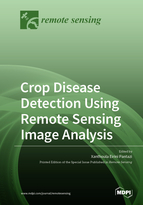Crop Disease Detection Using Remote Sensing Image Analysis
A special issue of Remote Sensing (ISSN 2072-4292). This special issue belongs to the section "Remote Sensing in Agriculture and Vegetation".
Deadline for manuscript submissions: closed (15 January 2022) | Viewed by 37860
Special Issue Editor
Interests: artificial intelligence; machine learning; data mining; data fusion; precision agriculture; biosystems; engineering; automation; sensors; yield prediction; crop disease detection; weed management
Special Issues, Collections and Topics in MDPI journals
Special Issue Information
Dear Colleagues,
Climate change and climate variability impact requires strategic innovations for timely and accurate plant disease assessment. Crop condition monitoring has a significant impact on disease control, limiting the tremendous effect to agricultural production, degrading yield and quality and consequently leading to severe financial loss for farmers. Conventional disease control is often based on the hypothesis that pathogenic factors are propagated uniformly over cultivated fields. Precision farming tools oriented to disease propagation assessment and location-dependent management are capable of leading to a lower environmental footprint yielded through lower pesticide application and relevant financial losses. Remote-sensing-based technologies have proven more effective compared to conventional ones on occasions where iterative large-scale measurements are needed as the only sole method for data acquisition. Innovative imaging sensor tools are capable of improving spatial and spectral resolution accuracies that enable not only the assessment of foliar symptoms (image, texture, and spectral sensors) and spatial disease manifestation, but also the evaluation of early detection approaches, aiming to detect changes in leaf optical behavior due to infection occurrence, which are not yet perceived by the human vision system (hyperspectral images). Recently, different approaches that are oriented to disease monitoring and detection through employing optical sensors fitted on a variety of platforms have been demonstrated, including portable solutions to satellite, aircraft, and unmanned aerial vehicles (UAVs) for efficient crop monitoring. Simultaneously, noticeable progress in the Artificial Intelligence (AI) field enables successful supervised and unsupervised image analysis based on deep learning methods to enhance the performance of crop health monitoring. This Special Issue aims to gather relevant research work of novel applications that employ remote sensing techniques for plant disease detection.
Dr. Xanthoula Eirini Pantazi
Guest Editor
Manuscript Submission Information
Manuscripts should be submitted online at www.mdpi.com by registering and logging in to this website. Once you are registered, click here to go to the submission form. Manuscripts can be submitted until the deadline. All submissions that pass pre-check are peer-reviewed. Accepted papers will be published continuously in the journal (as soon as accepted) and will be listed together on the special issue website. Research articles, review articles as well as short communications are invited. For planned papers, a title and short abstract (about 100 words) can be sent to the Editorial Office for announcement on this website.
Submitted manuscripts should not have been published previously, nor be under consideration for publication elsewhere (except conference proceedings papers). All manuscripts are thoroughly refereed through a single-blind peer-review process. A guide for authors and other relevant information for submission of manuscripts is available on the Instructions for Authors page. Remote Sensing is an international peer-reviewed open access semimonthly journal published by MDPI.
Please visit the Instructions for Authors page before submitting a manuscript. The Article Processing Charge (APC) for publication in this open access journal is 2700 CHF (Swiss Francs). Submitted papers should be well formatted and use good English. Authors may use MDPI's English editing service prior to publication or during author revisions.
Keywords
- Field spectroscopy
- Crop health status
- Precision agriculture
- Deep learning
- Data mining
- Hyperspectral sensors
- Sensor fusion
- Data fusion
- Multispectral sensors
- Machine learning
- Artificial Intelligence






